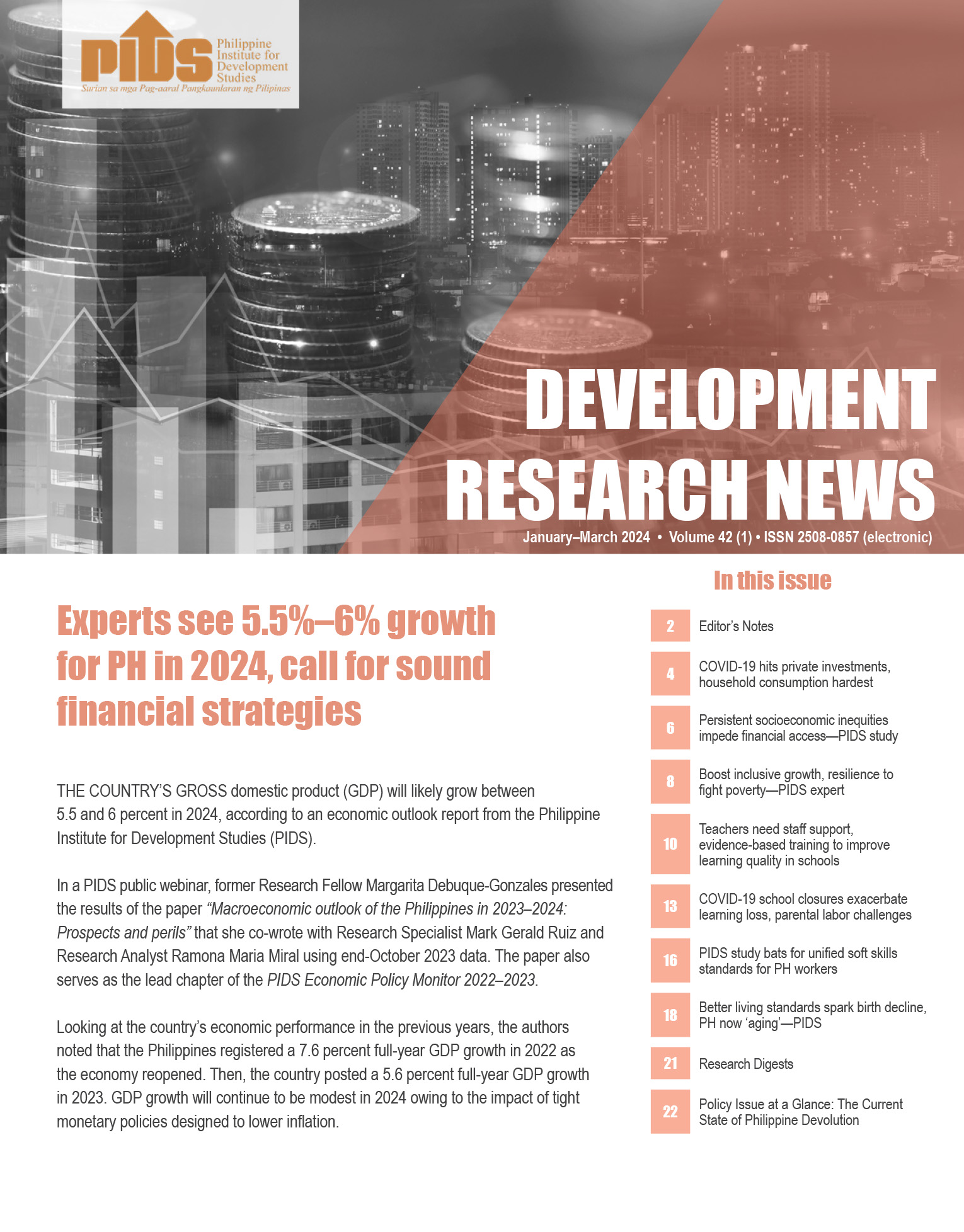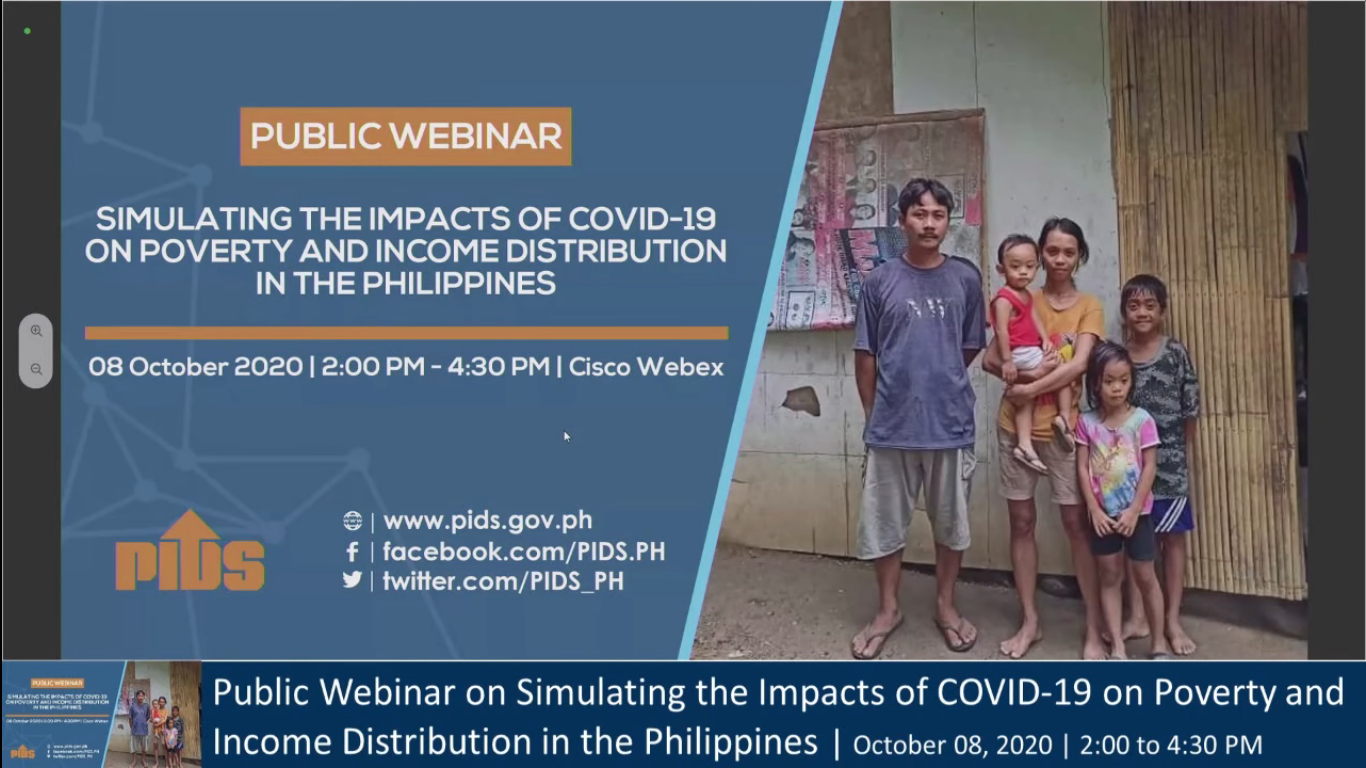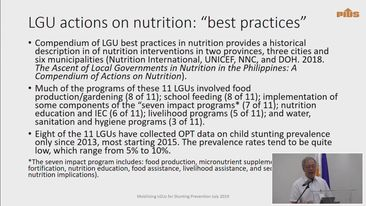PRIOR to the coronavirus pandemic, the Philippines was on track to meet its targets for reducing unemployment and poverty.
Poverty incidence among individuals — or the proportion of Filipinos whose incomes fell below the poverty threshold — was 16.7% in 2018, lower than the revised 23.5% recorded in 2015, according to the Philippine Statistics Authority (PSA). This was already near the Philippine Development Plan (PDP) 2017-2022 target of reducing poverty incidence to 14% by 2022.
According to the National Economic and Development Authority (NEDA), around 5.9 million Filipinos had been lifted out of poverty as of 2018 on track with its target of six million Filipinos by 2022.
At that time, the NEDA noted the country was likely to meet the Sustainable Development Goal (SDG) target of eradicating extreme poverty as defined by the international poverty line as well as cutting by half the proportion of the population living below the national poverty line by 2030.
The same could also be said about unemployment. The PSA’s Labor Force Survey (LFS) revealed a national unemployment rate of 5.1% in 2019 — its lowest since the adoption of a new unemployment definition in 2005. In the PDP 2017-2022, unemployment was targeted to go down by 3-5% by 2022.
With the ongoing health crisis, it is now unlikely these development goals will be attained.
“The government will likely find it difficult to bring the poverty rate down to 14% by 2022. The extended lockdowns have not only slashed jobs, they have compelled firms to restructure their operations post-COVID-19, which would likely require fewer investments in capital goods, except for IT-related spending,” University of Asia and the Pacific (UA&P) Economist Victor A. Abola told BusinessWorld in an e-mail.
In an upcoming paper, Ateneo de Manila University (ADMU) Economist Geoffrey M. Ducanes and former Socioeconomic Planning Secretary Arsenio M. Balisacan said poverty incidence is “likely to double or even triple relative to the 2018 level,” assuming no or minimal government transfers, the lockdown lasts for two months, and employment levels only gradually recover by yearend.
“Most low-income households are dependent on wage income and entrepreneurial income [for those that are self-employed], so unless this decline is offset by an increase in other income, such as government transfers, it is inevitable that poverty will increase,” Mr. Ducanes said in a separate e-mail interview.
Philippine Institute for Development Studies Senior Research Fellow Jose Ramon G. Albert estimated a 10% contraction in incomes during the pandemic, even with the Social Amelioration Program (SAP) and Small Business Wage Subsidy, will push poverty incidence to 18.2% from the 2018 baseline data.
Meanwhile, a simulation of a 20% drop in incomes, with both government programs implemented, will increase poverty incidence to 24.2%.
NEDA Acting Secretary Karl Kendrick T. Chua said last Tuesday that the increase in poverty incidence may be “very short-lived” as the majority of the poor are in rural areas. Mr. Chua said these areas are hardly affected by the government’s quarantine measures as COVID-19 cases are concentrated in urban areas. He said he does not see the temporary increase in the poverty rate of urban areas as a “prolonged problem.”
The poverty rate for individuals residing in urban areas stood at 9.3% in 2018 (from 13.2% in 2015) while for individuals in rural areas it is 24.5% (from 34%) according to PSA data.
Broken down, poverty incidence in the National Capital Region (2.2%), Central Luzon (7%), and Calabarzon (7.1%) — cited by Mr. Chua as urban areas — have lower poverty incidence than the national rate at 16.7%. However, the poverty rates in the remaining regions of Luzon, which have also undergone quarantine for at least a month and a half, were relatively close or higher than the national figure: Ilocos Region (9.9%), Cordillera Administrative Region (12%), Mimaropa (15.1%), Cagayan Valley (16.1%), and Bicol Region (27%).
As of June 5, the Department of Health reported that 11,656 or 57% of confirmed COVID-19 cases in the Philippines are in the NCR while 1,781 cases or 9% were in Calabarzon.
UNEMPLOYMENT
Along with rising poverty rates, the country would have to deal with the increase in unemployment levels.
The April round of the PSA’s LFS showed the unemployment rate rising to record high of 17.7% from 5.1% in April 2019. This is equivalent to an additional five million jobless Filipinos, bringing the total to more than seven million.
“My fear is that the worst of modern economics’ nightmares will happen — simultaneous massive unemployment and ever ratcheting price spirals (stagflation)…,” said Federico M. Macaranas, an adjunct professor at the Asian Institute Management (AIM) and a former Foreign Affairs undersecretary, in an e-mail interview last month.
Stagflation, a term coined in the 1970s, was characterized by persistently high inflation and unemployment levels. Alternatively, it can be defined as a period of accelerating inflation with a decline in the gross domestic product (GDP).
Mr. Macaranas said stagflation could persist only until productivity bounces back with the production of “real goods” along with innovative ideas.
“The most vulnerable in the short-term are the hard-core unemployed with no basic income for subsistence, or those working under contractual terms, small enterprises whose cash lifeline may not be sufficient to adopt new business models, and in the long-term even larger firms which lack creative minds to collaborate with good market-sensing, socially aware people,” Mr. Macaranas said.
For ADMU’s Mr. Ducanes, employment in restaurants, malls, and public transportation where physical distancing could be challenging is generally affected.
“Together, wholesale and retail trade, transportation and storage, accommodation and food service activities, construction, and manufacturing employ 21 million workers or about 50% of total employed in the country. A good portion of these workers is likely to have lost or to lose jobs because of COVID-19. To the extent that a large share of these workers belongs to low-income households… many will fall into poverty,” Mr. Ducanes said.
“The global recession is also likely to dampen demand for Philippine exports, thus possibly even affecting manufacturing and some agricultural jobs. Many OFWs (overseas Filipino workers), especially seamen and those working in countries that are hit hard economically by COVID-19 will lose their jobs,” the economist added.
MORE NEEDS TO BE DONE
“Because COVID-19, through its effect on employment and income, will also have a downstream effect also on enrollment and health outcomes… It will also negatively impact our hope of achieving a high level of human development by 2022,” Mr. Ducanes said.
In the near term, he said the government should extend or expand SAP even if the household is no longer under strict quarantine. While acknowledging the program can be very costly, he said targeting beneficiaries for cash grants and emergency employment programs would be key to keep Filipinos above the poverty line.
“The government needs to improve the social protection programs for the working poor, especially those in self-employment,” Mr. Ducanes said, noting that subsidized social security and unemployment insurance are necessary safety nets for the country’s vulnerable population.
“The government must also make sure to control inflation, especially for food, which has a big weight in the consumption basket of the poor. An extraordinary rise in food inflation of about 15% will be enough to offset the impact on poverty of the current SAP, according to our estimates,” he added.
For AIM’s Mr. Macaranas, government funds may soon run out when the more than $2 billion in COVID-19 support programs are extended.
“National finances can be supplemented by funds from international financial sources… If worse comes to worst, the government can sell more of its land assets, and reclaim more land from coastal urban centers,” he said.
Mr. Macaranas also said that private sector institutions should also be quick on their feet as “those who will be more successful are people who are more creative, collaborative, fast, agile, sustainability-driven, and technologically-savvy.”
For UA&P’s Mr. Abola, the government should provide subsidies and incentives to private schools in upscaling human capital to reduce the burden on state-owned institutions and improve education quality.
“Financial assistance should also focus a lot on the agricultural sector, where poverty is highest, so that they can shift to more high-value crops, as well as provide incentives for modern storage facilities. Help provide e-platforms so that farmers can maximize their earnings, instead of being held captive by middlemen,” Mr. Abola said.
He added infrastructure goals under the “Build, Build, Build” program “should not be sacrificed” in order to lower logistics costs in the country.
Poverty incidence among individuals — or the proportion of Filipinos whose incomes fell below the poverty threshold — was 16.7% in 2018, lower than the revised 23.5% recorded in 2015, according to the Philippine Statistics Authority (PSA). This was already near the Philippine Development Plan (PDP) 2017-2022 target of reducing poverty incidence to 14% by 2022.
According to the National Economic and Development Authority (NEDA), around 5.9 million Filipinos had been lifted out of poverty as of 2018 on track with its target of six million Filipinos by 2022.
At that time, the NEDA noted the country was likely to meet the Sustainable Development Goal (SDG) target of eradicating extreme poverty as defined by the international poverty line as well as cutting by half the proportion of the population living below the national poverty line by 2030.
The same could also be said about unemployment. The PSA’s Labor Force Survey (LFS) revealed a national unemployment rate of 5.1% in 2019 — its lowest since the adoption of a new unemployment definition in 2005. In the PDP 2017-2022, unemployment was targeted to go down by 3-5% by 2022.
With the ongoing health crisis, it is now unlikely these development goals will be attained.
“The government will likely find it difficult to bring the poverty rate down to 14% by 2022. The extended lockdowns have not only slashed jobs, they have compelled firms to restructure their operations post-COVID-19, which would likely require fewer investments in capital goods, except for IT-related spending,” University of Asia and the Pacific (UA&P) Economist Victor A. Abola told BusinessWorld in an e-mail.
In an upcoming paper, Ateneo de Manila University (ADMU) Economist Geoffrey M. Ducanes and former Socioeconomic Planning Secretary Arsenio M. Balisacan said poverty incidence is “likely to double or even triple relative to the 2018 level,” assuming no or minimal government transfers, the lockdown lasts for two months, and employment levels only gradually recover by yearend.
“Most low-income households are dependent on wage income and entrepreneurial income [for those that are self-employed], so unless this decline is offset by an increase in other income, such as government transfers, it is inevitable that poverty will increase,” Mr. Ducanes said in a separate e-mail interview.
Philippine Institute for Development Studies Senior Research Fellow Jose Ramon G. Albert estimated a 10% contraction in incomes during the pandemic, even with the Social Amelioration Program (SAP) and Small Business Wage Subsidy, will push poverty incidence to 18.2% from the 2018 baseline data.
Meanwhile, a simulation of a 20% drop in incomes, with both government programs implemented, will increase poverty incidence to 24.2%.
NEDA Acting Secretary Karl Kendrick T. Chua said last Tuesday that the increase in poverty incidence may be “very short-lived” as the majority of the poor are in rural areas. Mr. Chua said these areas are hardly affected by the government’s quarantine measures as COVID-19 cases are concentrated in urban areas. He said he does not see the temporary increase in the poverty rate of urban areas as a “prolonged problem.”
The poverty rate for individuals residing in urban areas stood at 9.3% in 2018 (from 13.2% in 2015) while for individuals in rural areas it is 24.5% (from 34%) according to PSA data.
Broken down, poverty incidence in the National Capital Region (2.2%), Central Luzon (7%), and Calabarzon (7.1%) — cited by Mr. Chua as urban areas — have lower poverty incidence than the national rate at 16.7%. However, the poverty rates in the remaining regions of Luzon, which have also undergone quarantine for at least a month and a half, were relatively close or higher than the national figure: Ilocos Region (9.9%), Cordillera Administrative Region (12%), Mimaropa (15.1%), Cagayan Valley (16.1%), and Bicol Region (27%).
As of June 5, the Department of Health reported that 11,656 or 57% of confirmed COVID-19 cases in the Philippines are in the NCR while 1,781 cases or 9% were in Calabarzon.
UNEMPLOYMENT
Along with rising poverty rates, the country would have to deal with the increase in unemployment levels.
The April round of the PSA’s LFS showed the unemployment rate rising to record high of 17.7% from 5.1% in April 2019. This is equivalent to an additional five million jobless Filipinos, bringing the total to more than seven million.
“My fear is that the worst of modern economics’ nightmares will happen — simultaneous massive unemployment and ever ratcheting price spirals (stagflation)…,” said Federico M. Macaranas, an adjunct professor at the Asian Institute Management (AIM) and a former Foreign Affairs undersecretary, in an e-mail interview last month.
Stagflation, a term coined in the 1970s, was characterized by persistently high inflation and unemployment levels. Alternatively, it can be defined as a period of accelerating inflation with a decline in the gross domestic product (GDP).
Mr. Macaranas said stagflation could persist only until productivity bounces back with the production of “real goods” along with innovative ideas.
“The most vulnerable in the short-term are the hard-core unemployed with no basic income for subsistence, or those working under contractual terms, small enterprises whose cash lifeline may not be sufficient to adopt new business models, and in the long-term even larger firms which lack creative minds to collaborate with good market-sensing, socially aware people,” Mr. Macaranas said.
For ADMU’s Mr. Ducanes, employment in restaurants, malls, and public transportation where physical distancing could be challenging is generally affected.
“Together, wholesale and retail trade, transportation and storage, accommodation and food service activities, construction, and manufacturing employ 21 million workers or about 50% of total employed in the country. A good portion of these workers is likely to have lost or to lose jobs because of COVID-19. To the extent that a large share of these workers belongs to low-income households… many will fall into poverty,” Mr. Ducanes said.
“The global recession is also likely to dampen demand for Philippine exports, thus possibly even affecting manufacturing and some agricultural jobs. Many OFWs (overseas Filipino workers), especially seamen and those working in countries that are hit hard economically by COVID-19 will lose their jobs,” the economist added.
MORE NEEDS TO BE DONE
“Because COVID-19, through its effect on employment and income, will also have a downstream effect also on enrollment and health outcomes… It will also negatively impact our hope of achieving a high level of human development by 2022,” Mr. Ducanes said.
In the near term, he said the government should extend or expand SAP even if the household is no longer under strict quarantine. While acknowledging the program can be very costly, he said targeting beneficiaries for cash grants and emergency employment programs would be key to keep Filipinos above the poverty line.
“The government needs to improve the social protection programs for the working poor, especially those in self-employment,” Mr. Ducanes said, noting that subsidized social security and unemployment insurance are necessary safety nets for the country’s vulnerable population.
“The government must also make sure to control inflation, especially for food, which has a big weight in the consumption basket of the poor. An extraordinary rise in food inflation of about 15% will be enough to offset the impact on poverty of the current SAP, according to our estimates,” he added.
For AIM’s Mr. Macaranas, government funds may soon run out when the more than $2 billion in COVID-19 support programs are extended.
“National finances can be supplemented by funds from international financial sources… If worse comes to worst, the government can sell more of its land assets, and reclaim more land from coastal urban centers,” he said.
Mr. Macaranas also said that private sector institutions should also be quick on their feet as “those who will be more successful are people who are more creative, collaborative, fast, agile, sustainability-driven, and technologically-savvy.”
For UA&P’s Mr. Abola, the government should provide subsidies and incentives to private schools in upscaling human capital to reduce the burden on state-owned institutions and improve education quality.
“Financial assistance should also focus a lot on the agricultural sector, where poverty is highest, so that they can shift to more high-value crops, as well as provide incentives for modern storage facilities. Help provide e-platforms so that farmers can maximize their earnings, instead of being held captive by middlemen,” Mr. Abola said.
He added infrastructure goals under the “Build, Build, Build” program “should not be sacrificed” in order to lower logistics costs in the country.












